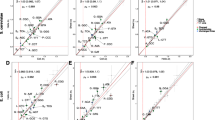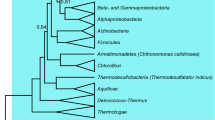Summary
A model of synonymous codon usage is developed in which the most frequent codons are selectively advantageous because of their coadaptation with tRNA abundances. Random drift opposes the progress of this coevolution by pushing codon frequencies in the direction of the frequency that would result from mutation in the absence of selection. It is predicted that, within a certain range, an increased mutation bias away from an advantageous codon has little influence on its usage in highly expressed genes. However, a subsequent small increase in mutation bias over a critical range leads to a large reduction in the frequency of the codon. The switch in preference from one synonym to another is a sharp transition, with no stable intermediate state in which neither codon is advantageous. Codon usage patterns were compared among three related bacterial species of differing genomic G+C contents,Escherichia coli, Serratia marcescens, andProteus vulgaris. It was found that although changes in mutation biases do not always result in switches in codon preferences, some switches have occurred in the direction of species-specific mutation biases. Fluctuating mutation biases may therefore be the main cause of differences between species in their codon preferences.
Similar content being viewed by others
References
Bulmer M (1987) Coevolution of codon usage and transfer RNA abundance. Nature 325:728–730
Bulmer M (1988) Are codon usage patterns in unicellular organisms determined by selection-mutation balance? J Evol Biol 1:15–16
Chavancy G, Garel J-P (1981) Does quantitative tRNA adaptation to codon content in mRNA optimise the ribosomal translation efficiency? Proposal for a translation system model. Biochimie 63:187–195
Ching G, Inouye M (1985) Evolution of the lipoprotein gene in the Enterobacteriaceae. J Mol Biol 185:501–507
Cole ST (1982) Nucleotide sequence coding for the flavoprotein subunit of the fumarate reductase ofEscherichia coli. Eur J Biochem 122:479–484
Cole ST (1987) Nucleotide sequence and comparative analysis of thefrd operon encoding the fumarate reductase ofProteus vulgaris. Eur J Biochem 167:481–488
Cole ST, Grundstroem T, Jaurin B, Robinson, JJ, Weiner JH (1982) Location and nucleotide sequence offrdB, the gene coding for the iron-sulphur protein subunit of the fumarate reductase ofEscherichia coli. Eur J Biochem 126:211–216
Ehrenberg M, Kurland CG (1984) Costs of accuracy determined by a maximal growth constant. Q Rev Biophys 17:45–82
Gouy M, Gautier C (1982) Codon usage in bacteria: correlation with gene expressivity. Nucleic Acids Res 10:7055–7074
Grantham R, Gautier C, Gouy M (1980) Codon frequencies in 119 individual genes confirm consistent choices of degenerate bases according to genome type. Nucleic Acids Res 8:1893–1912
Grosjean H, Fiers W (1982) Preferential codon usage in prokaryotic genes: the optimal codon-anticodon interaction energy and the selective codon usage in efficiently expressed genes. Gene 18:199–209
Grundstroem T, Jaurin B (1982) Overlap betweenampC andfrd operons on theEscherichia coli chromosome. Proc Natl Acad Sci USA 79:1111–1115
Ikemura T (1981) Correlation between the abundance ofEscherichia coli transfer RNAs and the occurrence of the respective codons in its protein genes: a proposal for a synonymous codon choice that is optimal for theE. coli translational system. J Mol Biol 151:389–409
Ikemura T (1982) Correlation between the abundance of yeast transfer RNAs and the occurrence of the respective codons in protein genes. J Mol Biol 158:573–597
Ikemura T (1985) Codon usage and tRNA content in unicellular and multicellular organisms. Mol Biol Evol 2:13–34
Kimura M (1983) The neutral theory of molecular evolution. Cambridge University Press, Cambridge, p 45
Li W-H (1987) Models of nearly neutral mutations with particular implications for nonrandom usage of synonymous codons. J Mol Evol 24:337–345
Muto A, Osawa S (1987) The guanine and cytosine content of genomic DNA and bacterial evolution. Proc Natl Acad Sci USA 84:166–169
Nishimura S (1978) Modified nucleosides and isoaccepting tRNA. In: Altman S (ed) Transfer RNA. MIT Press, Cambridge MA, pp 168–195
Normore WM, Brown JR (1970) Guanine plus cytosine (G+C) composition of bacteria. In: Sober HA (ed) CRC handbook of biochemistry selected data for molecular biology, ed 2. CRC, Cleveland OH, pp H24-H74
Osawa S, Ohama T, Yarnao F, Muto A, Jukes TH, Ozeki H, Umesono K (1988) Directional mutation pressure and transfer RNA in choice of the third nucleotide of synonymous two-codon sets. Proc Natl Acad Sci USA 85:1124–1128
Post LE, Strycharz GD, Nomura M, Lewis H, Dennis PP (1979) Nucleotide sequence of the ribosomal protein gene cluster adjacent to the gene for RNA polymerase subunit inEscherichia coli. Proc Natl Acad Sci USA 76:1697–1701
Sharp PM (1990) Processes of genome evolution reflected by base frequency differences amongSerratia marcescens genes. Mol Microbiol 4:119–122
Sharp PM, Li W-H (1986) Codon usage in regulatory genes inEscherichia coli does not reflect selection for “rare” codons. Nucleic Acids Res 14:7737–7749
Sharp PM, Li W-H (1987) The codon adaptation index—a measure of directional synonymous codon bias, and its potential applications. Nucleic Acids Res 15:1281–1295
Sharp PM, Cowe E, Higgins DG, Shields DC, Wolfe KH, Wright F (1988) Codon usage patterns inEscherichia coli, Bacillus subtilis, Saccharomyces cerevisiae, Schizosaccharomyces pombe, Drosophila melanogaster andHomo sapiens; a review of the considerable within-species diversity. Nucleic Acids Res 16:8207–8211
Shields DC, Sharp PM (1987) Synonymous codon usage inBacillus subtilis reflects both translational selection and mutational biases. Nucleic Acids Res 15:8023–8040
Sor F, Nomura M (1987) Cloning and DNA sequence determination of the L11 ribosomal protein operon ofSerratia marcescens andProteus vulgaris: translational feedback regulation of theEscherichia coli L11 operon by heterologous L1 proteins. Mol Gen Genet 210:52–59
Sueoka N (1988) Directional mutation pressure and neutral molecular evolution. Proc Natl Acad Sci USA 85:2653–2657
Von Heijne G, Blomberg C (1979) The concentration dependence of the error frequencies and some related qualities in protein synthesis. J Theor Biol 78:113–120
Wright S (1931) Evolution in Mendelian populations. Genetics 16:97–159
Wright S (1977) Evolution and the genetics of populations, vol 3. Experimental results and evolutionary deductions. University of Chicago Press, Chicago
Author information
Authors and Affiliations
Rights and permissions
About this article
Cite this article
Shields, D.C. Switches in species-specific codon preferences: The influence of mutation biases. J Mol Evol 31, 71–80 (1990). https://doi.org/10.1007/BF02109476
Received:
Revised:
Accepted:
Issue Date:
DOI: https://doi.org/10.1007/BF02109476




